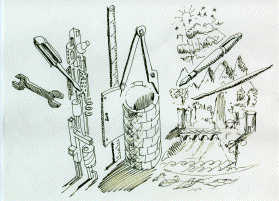
The Ceiling |
| the "unofficial" Duncan Hall web site |
| Rice University |
| Houston, Texas, USA |
 |
|

It is a rather unusual and eye-catching feature. In Martel Hall, you can always tell the first-time visitor. will see someone enter for the first time. Their eyes are drawn upward; they usually gasp.
The ceiling tells a story-a cosmological, philosophical story. Outram has told several versions of the story, the interested reader is encouraged to visit his web site. We have recorded an abridged version of one such explanation.
For a contrast, consider the ceiling of his Judge Institute at Cambridge. Here, the ceiling consists of a series of closed irises, revealing only a hint of what lies beyond.
One parent's reaction to the ceiling surprised me. He was concerned that we had "wasted tuition money" on such frivolous art. Two facts about the ceiling calmed him. First, the ceiling was generously donated by Steve and Sue Shaper, of Houston. Thus, no tuition dollars were spent. Second, the ceiling was produced using cost effective techniques that are, to my knowledge, novel in the realm of architecture.
The result is a striking and inexpensive decorated ceiling, produced for a cost that is less that the cost of the roughly 400 door handles in the building.
Anytime you take an A1-sized sheet of paper and blow it up to
a size of roughly fifty-five by seventy-five feet, you should
expect to find some scanning artifacts.
Several such artifacts can be seen in the ceiling. Dirt, too small
for the human eye to notice on the original, shows up on the final
ceiling. Similarly, several small pencil marks can be found in
the lighter colored regions of the ceiling.